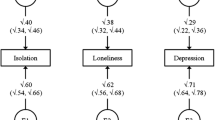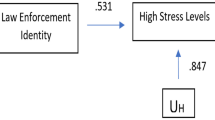Abstract
Background
This study examined the relationship between recent negative life events, level of acculturation and other psychosocial risk factors in predicting major depression in Chinese Americans.
Method
Data were collected on 1,747 Chinese immigrants and native-born residents of the United States (ages 18–65) who resided in Los Angeles County between 1993 and 1994.
Results
Findings indicated that a positive psychiatric history increased risk for major depression at Time 2, while social conflicts and traumatic life events moderated the effects of negative life events in increasing risk for major depression. In addition, level of acculturation moderated the effects of recent negative events in increasing risk, but only for those who were more highly acculturated.
Conclusions
The importance of testing the cross-cultural applicability of the stress-vulnerability hypothesis among ethnic minorities and extending them to include immigrant vulnerabilities is discussed



Similar content being viewed by others
References
Hwang W, Myers HF, Takeuchi T (2000) Psychosocial predictors of first-onset depression in Chinese Americans. Soc Psychiatry Psychiatr Epidemiol 35:133–145
Takeuchi DT, Chung RC, Lin KM, Shen H, Kurasaki K, Chun C, Sue S (1998) Lifetime and twelve-month prevalence rates of major depressive episodes and dysthymia among Chinese Americans in Los Angeles. Am J Psychiatry 155:1407–1414
Monroe SM, Simons AD (1991) Diathesis-stress theories in the context of life stress research: Implications for the depressive disorders. Psychol Bull 110:406–425
Beekman A, de Beurs E, van Balkom A, Deeg D, van Dyck R, van Tilburg W (2000) Anxiety and depression in later life: Co-occurrence and communality of risk factors. Am J Psychiatry 157(1):89–95
Hammen C (2005) Stress and depression. Annu Rev Clin Psychol 1:293–319
Hammen C, Henry R, Daley SE (2000) Depression and sensitization to stressors among young women as a function of childhood adversity. J Consult Clin Psychol 68(5): 782–787
Kendler KS, Thornton LM, Gardner CO (2000) Stressful life events and previous episodes in the etiology of major depression in women: An evaluation of the “Kindling” hypothesis. Am J Psychiatry 157(8):1243–1251
Lewinsohn PM, Rohde P, Seeley JR, Hops H (1991) Comorbidity of unipolar depression: I. Major depression with dysthymia. J Abnorm Psychol 100(2):205–213
Lewinsohn PM, Hoberman HM, Rosenbaum M (1988) A prospective study of risk factors for unipolar depression. J Abnorm Psychol 97(3):251–264
McGonagle KA, Kessler RC (1990) Chronic stress, acute stress, and depressive symptoms. Am J Community Psychol 18(5):681–706
Escobar JI (1998) Immigration and mental health: Why are immigrants better off? Arch Gen Psychiatry 55:781–782
Escobar JI, Vega WA (2000) Mental health and Immigration’s AAA: Where are we and where do we go from here? J Nerv Ment Dis 188(11):736–740
Berry JW (1998) Acculturation and health: theory and research. In: Kazarian S, Evans D (eds) Cultural clinical psychology: theory, research, and practice. Oxford University Press, New York, pp 39–57
Burnam MA, Hough RL, Karno M, Escobar JI, Telles C (1987) Acculturation and lifetime prevalence of psychiatric disorders among Mexican Americans in Los Angeles. J Health Soc Behav 28:89–102
Kessler RC, McGonagle KA, Zhao S, Nelson CB, Hughes M, Eshleman S, Wittchen H, Kendler KS (1994) Lifetime and 12-month prevalence of DSM-III-R psychiatric disorders in the United States. Arch Gen Psychiatry 51:8–19
Rogler LH, Cortes DE, Malgady RG (1991) Acculturation and mental health status among Hispanics: convergence and new directions for research. Am Psychol 46(6):585–597
Vega WA, Kolody B, Aguilar-Gaxiola S, Alderete E, Catalano R, Caraveo-Anduaga J (1998) Lifetime prevalence of DSM-III-R psychiatric disorders among urban and rural Mexican Americans in California. Arch Gen Psychiatry 55:771–778
Hwang W, Chun C, Takeuchi DT, Myers HF, Prabha S (2005) Age at first-onset depression among Chinese Americans. Cultur Divers Ethnic Minor Psychol 11(1):16–27
Hwang W, Chun C, Kurasaki K, Mak W, Takeuchi DT (2000a) Factor validity of scores on a social support and conflict measure among Chinese Americans. Educ Psychol Meas 60(5):808–816
Hwu H, Yeh E, Chang L (1986a) Chinese diagnostic interview schedule. I. agreement with psychiatrist’s diagnosis. Acta Psychiatr Scand 73:225–233
Hwu H, Yeh E, Chang L, Yeh Y (1986b) Chinese diagnostic interview schedule. II. a validity study on estimation of lifetime prevalence. Acta Psychiatr Scand 73:348–357
Hwu H, Yeh E, Chang L (1989) Prevalence of psychiatric disorders in Taiwan defined by the Chinese diagnostic interview schedule. Acta Psychiatr Scand 79:136–147
Semler G, Von Cranach M, Wittchen H (1987) Comparisons between the composite international diagnostic interview and the present state examination. Report to the WHO/ADAMHA task force on instrument development. WHO, Geneva
Spengler P, Wittchen H (1989) Procedural validity of standardized symptom questions for the assessment of psychotic symptoms: a comparison of the CIDI with two clinical methods. Compr Psychiatry 29:309–322
Janca A, Robins LN, Bucholz KK, Early TS, Shayka JJ (1992) Comparisons of composite international diagnostic interview and clinical DSM-III-R criteria checklist diagnoses. Acta Psychiatr Scand 85:440–443
Robins LN, Helzer JE, Croughan J, Ratcliff KL (1981) National institute of mental health diagnostic interview schedule: its history, characteristics, and validity. Arch Gen Psychiatry 38:381–389
Schuster TL, Kessler RC, Aseltine Jr RH (1990) Supportive interactions, negative interactions, and depressed mood. Am J Community Psychol 18(3):423–438
Turner RJ, Frankel G, Levin DM (1983) Social support: conceptualization, measurement, and implications for mental health. In: Greenley JR, Simmons RG (eds) Research in Community and Mental Health. JAI Press, Greenwhich, pp 67–111
Abe-Kim J, Takeuchi DT, Hwang W (2002) Predictors of help seeking for emotional distress among Chinese Americans: Family matters. J Consult Clin Psychol 70(5):1186–1190
Greenberger E, Chen C, Tally SR, Qi D (2000) Family, peer, and individual correlates of depressive symptomatology among U.S. and Chinese adolescents. J Consult Clin Psychol 68(2):209–219
Hammen C (1991) Generation of stress in the course of unipolar depression. J Abnorm Psychol 100(4):555–561
Daley SE, Hammen C, Burge D, Davila J, Paley B, Lindberg N, Herzberg DS (1997) Predictors of the generation of episodic stress: a longitudinal study of late adolescent women. J Abnorm Psychol 106(2):251–259
Resnick HS, Kilpatrick DG, Best CL, Kramer TL (1992) Vulnerability-stress factors in development of posttraumatic stress disorder. J Nerv Ment Dis 7(180):424–430
Rundell JR, Ursano RJ, Holloway HC, Silberman EK (1989) Psychiatric responses to trauma. Hosp Community Psychiatry 40(1):68–74
Hankin BL, Abramson LY, Moffitt TE, Silva PA, McGee R, Angell KE (1998) Development of depression from preadolescence to young adulthood: Emerging gender differences in a 10-year longitudinal study. J Abnorm Psychol 107(1):128–140
Kuo W (1984) Prevalence of depression among Asian-Americans. J Nerv Ment Dis 172:449–457
Nicassio PM (1985) The psychosocial adjustment of the Southeast Asian refugee. J Cross Cult Psychol 16(2):153–173
Abe-Kim J, Okazaki J, Goto SG (2001) Unidimensional versus multidimensional approaches to the assessment of acculturation for Asian American populations. Cultur Divers Ethnic Minor Psychol 7(3):232–246
Phinney JS, Horenczyk G, Liebkind K, Vedder P (2001) Ethnic identity, immigration, and well-being: an international perspective. J Soc Issues 57:493–510
Brown GW, Harris TO (1978) Social origins of depression: A study of psychiatric disorders in women. New York: Free Press
Hammen C (1997) Depression. East Sussex, UK: Psychology Press Ltd.
Acknowledgements
Support for this study was provided by NIMH Grants 47460 and 44331.
Author information
Authors and Affiliations
Corresponding author
Rights and permissions
About this article
Cite this article
Hwang, WC., Myers, H.F. Major depression in Chinese Americans. Soc Psychiat Epidemiol 42, 189–197 (2007). https://doi.org/10.1007/s00127-006-0152-1
Accepted:
Published:
Issue Date:
DOI: https://doi.org/10.1007/s00127-006-0152-1




